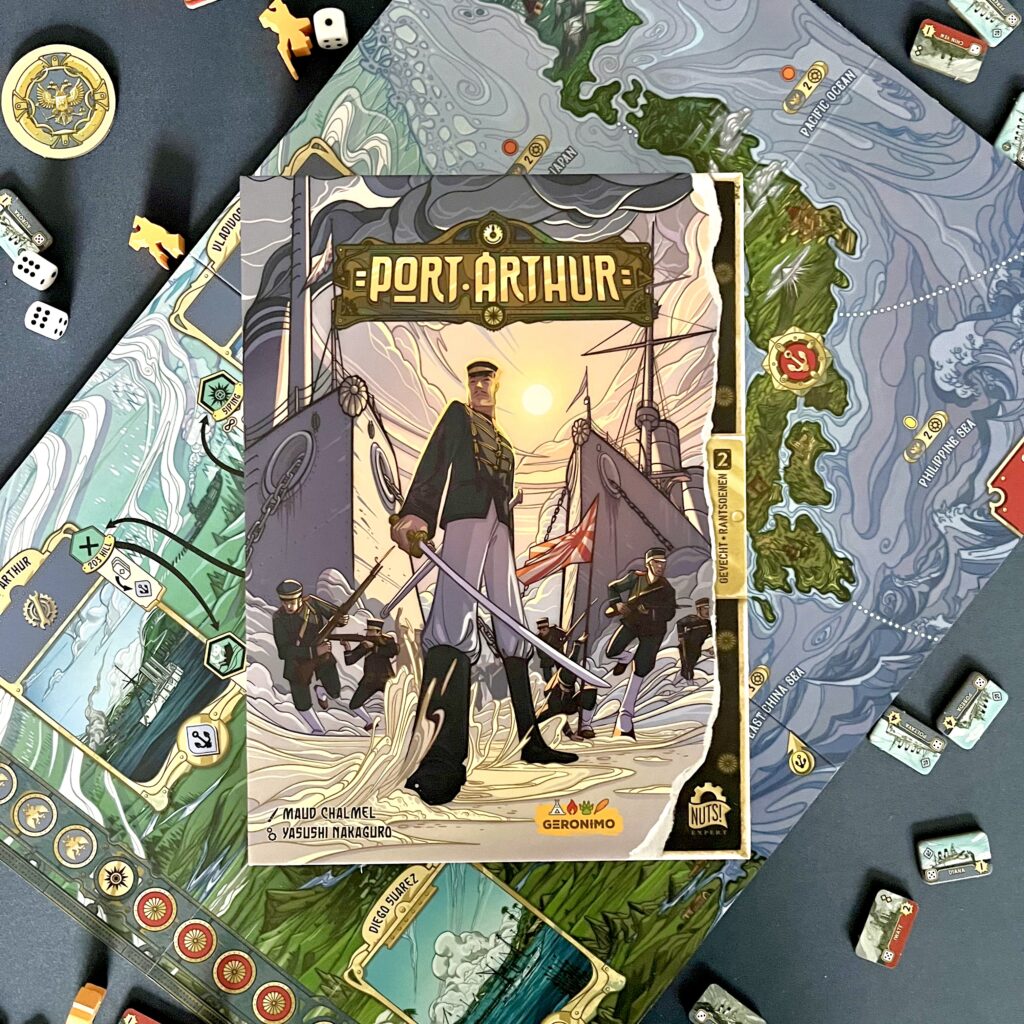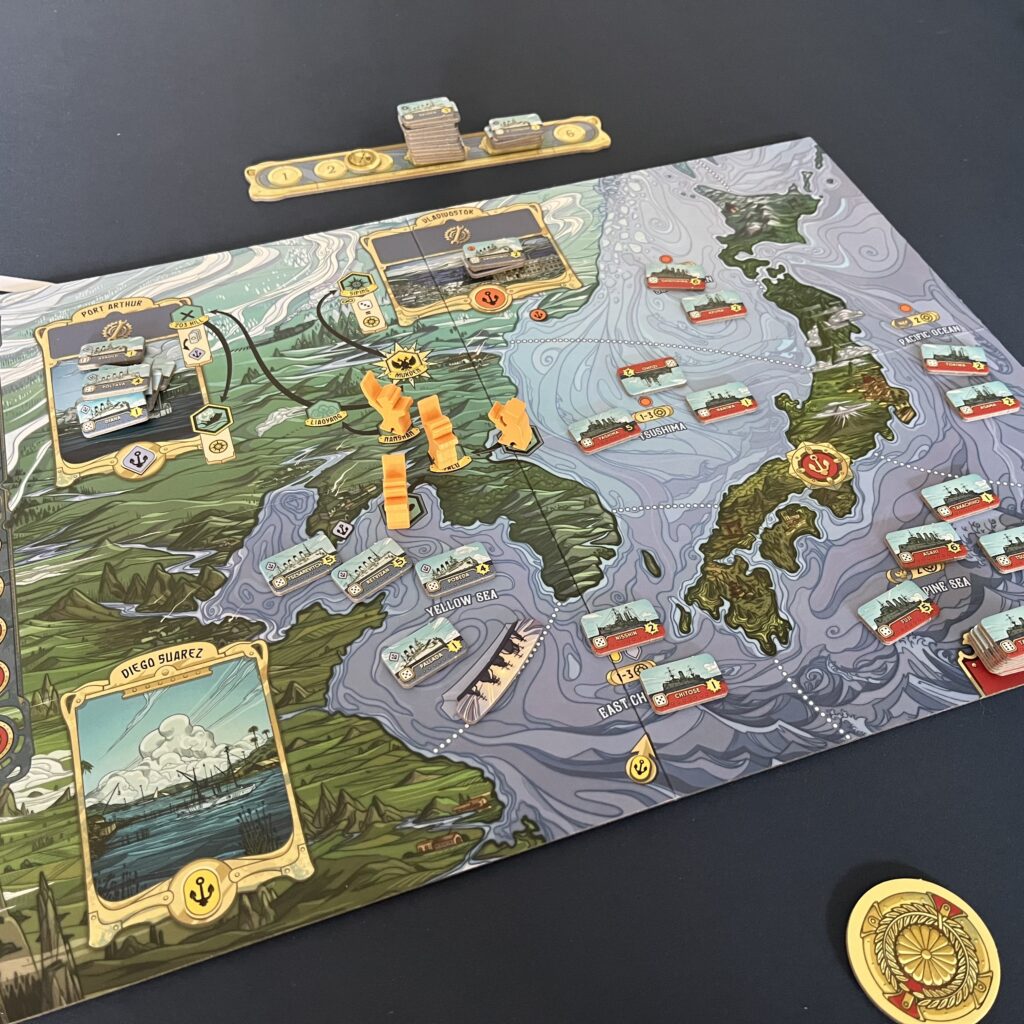The Russo-Japanese War of 1904-1905 lasted about 1.5 years and had a long antecedent history motivated by political and colonial sentiment. In Port Arthur, two players reenact important elements of the war in an asymmetrical battlefield (on the sea).
Background
The other day I spoke with Florent Coupeau, the CEO of Nuts! Publishing and author of several wargames. Nuts! Publishing is one of the best-known publishers of war games, realistic games that recreate – often true-life – conflicts. Nuts! is also the international publisher of the game Port Arthur, which is published in Dutch by the Belgian Geronimo Games. Many topics passed in review during the conversation with Florent, including his personal fondness for wargames and history. He emphasized that he is a pacifist and explained that many members of the European wargaming community follow that same line of thought. War is not desirable and history teaches us of the despicable scenes of war and the suffering that results from war. Some people may find it crude to “play war,” but wargames have educational value in addition to entertainment. Wargames can teach you about the underlying conflict, context and history. To learn about the future, you have to know history.

The title Port Arthur refers to a port near the Yellow Sea that played a crucial role in the Russo-Japanese War in the early 20th century. This conflict was overshadowed in history classes in Western Europe by immediately palpable wars and events, but the Russo-Japanese War is still palpable in relations in Asia.
In Port Arthur, a two-player strategic game, elements of the Russo-Japanese War take center stage, such as the capture of the titular Port Arthur but also the invasion of Manchuria. Before I played the game and began writing this review, I was familiar with the conflict, but I have since been able to read up a bit and learn about it. The game materials also include references and source citations, allowing players to learn more about the conflict if desired.
As an aside, Port Arthur is a design by Japanese game author Yasushi Nakaguro who also previously designed 300 Earth & Water. These two games are the first two volumes of the battle ration series Nuts! published in Dutch by Geronimo Games.The battle rations consist of small thin boxes with compact game elements, but with extensive and complex gameplay.
Setup & gameplay
At the beginning of the game, players lay out the board and the various components. Port Arthur is an asymmetrical game. This means that the game setup and gameplay is different for both players. One player takes the role of the Russian army and the other player takes the role of the Japanese army.
The objectives and win conditions are also asymmetrical. For both players it is important to capture maritime territories for power, but for the Russian player it is important to keep the Japanese out of Manchuria, because if there are no Japanese soldiers on Muiden at the end of the sixth round, Russia wins. Otherwise, the player with the most power wins. The power track is scored during the game the game as a kind of rig-of-war between players.

Each round has a similar progression. Fleets sail out (where in rounds 4 and 5, the Russian player gains access over ships of the Baltic fleet), players perform actions, players score on the power track. As fleets sail out, players may move ships before they will take actions and can prepare as it were. Before actions are taken, a die is rolled to determine the order, here the player can influence more initiative the roll. Whether players take actions depends on whether players pass. With their actions, players can move ships and perform naval battles where the dice along with speed (during a move) and their firepower and defense (during a battle) determines the outcome.
Depending on certain conditions, events take place. For example, the Japanese player can lay down a blockade at Port Arthur or land troops to move across Manchuria with some spaces on the associated track triggering effects. Russia, however, can sink the transport of these soldiers.
Conclusion
As I described in the background to this review, the battle ration series consists of small thin boxes with compact game elements, but with extensive and complex gameplay.
We already wrote a rave review about the first title in the series, because of its thematic gameplay and fantastic handling of history. This is no different for Port Arthur, by the way. Once again, this is a small but powerful package of interesting gameplay. The game material is top notch and the gameplay is streamlined. The game follows clear rounds and leaves enough freedom for players to make weighty choices without compromising the realism of the game. I appreciate the historical context and the choices the author made to incorporate the context into the gameplay.



